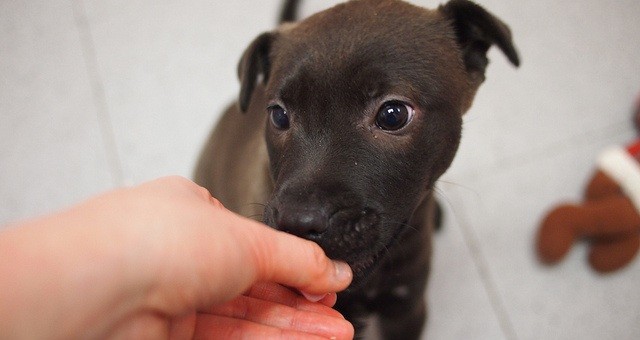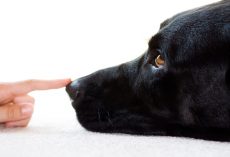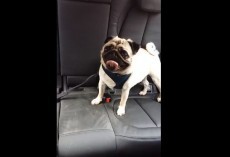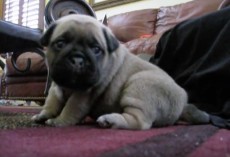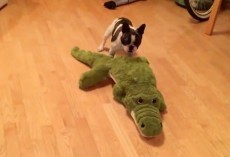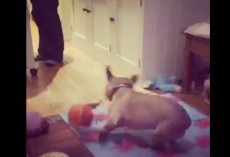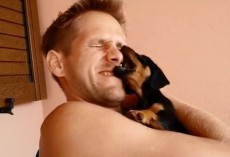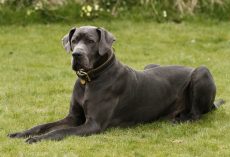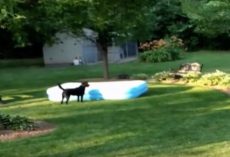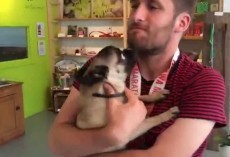If your pooch is biting too hard, it may be out of aggression or fear. If this is the case, you're going to have to work to break her current habits. She may just not have just learned when she was younger how to play appropriately and chew. If this is the case be patient with her and reprimand her when she does bite too hard. Instead substitute your hand or a toy or distract her. Be patient as you teach her new habits that ASPCA suggests and sway her from “mouthing” and potential biting.
Adult dogs who mouth people probably never learned not to do so during puppyhood. It’s likely that their human parents didn’t teach them how to be gentle or to chew toys instead.
Is It Playful Mouthing or Aggressive Behavior?
Most mouthing is normal dog behavior. But some dogs bite out of fear or frustration, and this type of biting can indicate problems with aggression. It’s sometimes difficult to tell the difference between normal play mouthing and mouthing that precedes aggressive behavior. Serious, aggressive bites are usually quicker and more painful than those delivered during play.If you suspect that your dog’s biting fits the description of aggressive behavior, please consult a qualified professional, such as a Certified Applied Animal Behaviorist (CAAB or ACAAB) or a board-certified veterinary behaviorist (Dip ACVB).
How to Minimize Your Dog’s Mouthing and Nipping
Dogs spend a great deal of time playing, chewing and investigating objects.
It’s important to help your dog learn to curb his mouthy behavior. There are various ways to teach this lesson, some better than others. The ultimate goal is to train your dog to stop mouthing and biting people altogether.Bite Inhibition: Teach Your Dog to Be Gentle
Bite inhibition refers to a dog’s ability to control the force of his mouthing. A puppy or dog who hasn’t learned bite inhibition with people doesn’t recognize the sensitivity of human skin, so he bites too hard, even in play.Young dogs usually learn bite inhibition during play with other dogs. If dogs can learn from each other how to be gentle, they can learn the same lesson from people.
When you play with your dog, let him mouth on your hands. Continue play until he bites especially hard. When he does, immediately give a high-pitched yelp, as if you’re hurt, and let your hand go limp. If your dog bites you hard again, yelp again. Repeat these steps no more than three times within a 15-minute period.
If you find that yelping alone doesn’t work, you can switch to a time-out procedure. Time-outs are often effective for curbing mouthy behavior in adolescent and adult dogs. When your dog delivers a hard bite, yelp loudly. Then, when he startles and turns to look at you or looks around, remove your hand. Either ignore him for 10 to 20 seconds or, if he starts mouthing on you again, get up and move away for 10 to 20 seconds.
What to Do Next: Teach Your Dog That Teeth Don’t Belong on Human Skin
After you teach your dog to be gentle with his mouth, you can move on to the next step: teaching him to avoid mouthing people altogether. Try the following tips:
• Substitute a toy or chew bone when your dog tries to gnaw on fingers or toes.
• Dogs often mouth on people’s hands when stroked, patted and scratched. If your dog gets all riled up when you pet him, distract him by feeding him small treats from your other hand.
• Encourage noncontact forms of play, such as fetch and tug-of-war, rather than wrestling and rough play with your hands.
• If your dog bites at your feet and ankles, carry his favorite tug toy in your pocket. Whenever he ambushes you, instantly stop moving your feet. Take out the tug toy and wave it enticingly. When your dog grabs the toy, start moving again.
• Provide plenty of interesting and new toys and things to chew so that your dog will play with them instead of gnawing on you or your clothing.
• Alternatively, you can keep a leash attached to your dog when you’re around to supervise him. Let the leash drag on the floor. Instead of leaving the room when your dog mouths you, you can immediately take hold of his leash and calmly lead him to a quiet area.General Precautions
• Avoid waving your fingers or toes in your dog’s face or slapping the sides of his face to entice him to play. Doing these things can actually encourage your dog to bite your hands and feet.
• Do not discourage your dog from playing with you in general. Play builds a strong bond between a dog and his human family. You want to teach your dog to play gently rather than not at all.
• Avoid jerking your hands or feet away from your dog when he mouths. Jerky movements might seem like a game to your dog and encourage him to jump forward and grab at you.

